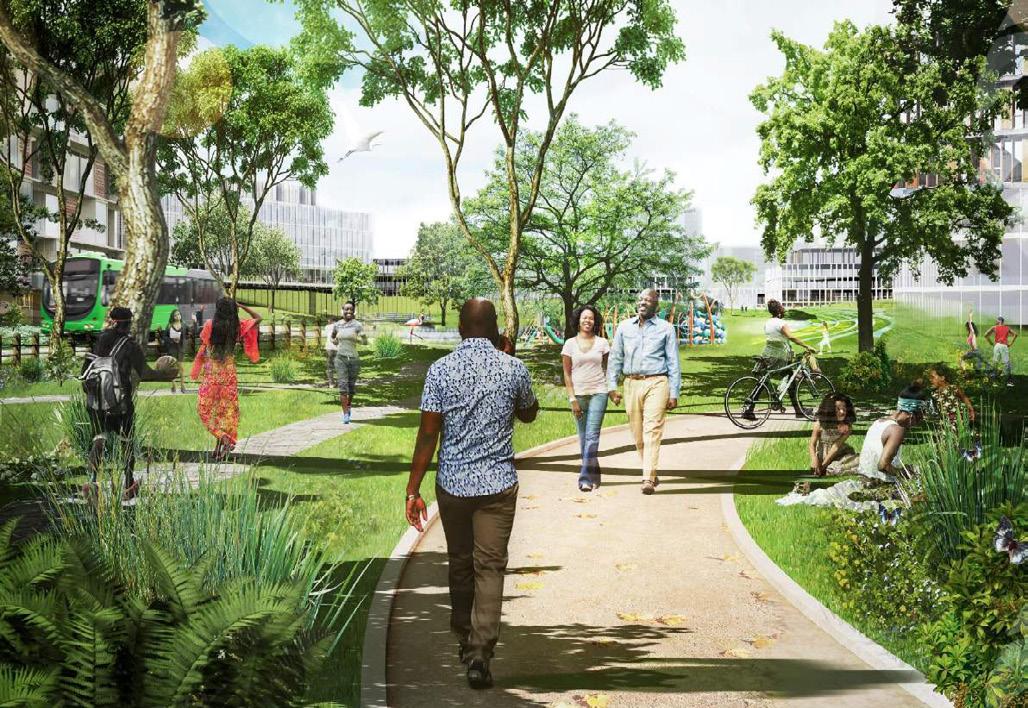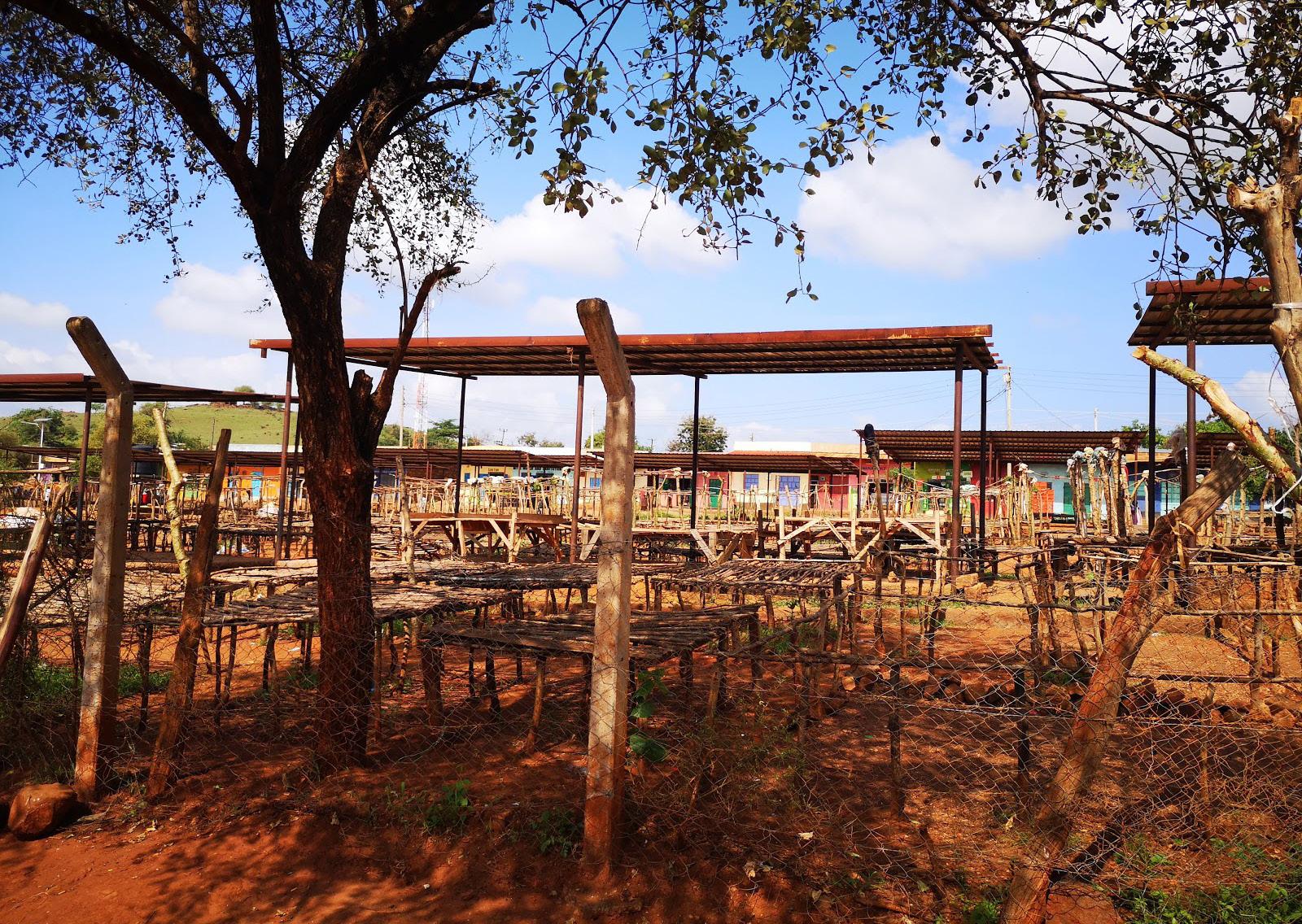8 minute read
3.3 Key Components of the Development Concept
Next Article
3.2 Visioning exercise
Part of the UEP process is developing an economic vision statement for Kathwana. This is complementary to the vision developed as part of the UDPF and more suited to the scope (short/medium-term) and focus (economic activity) of the UEP. In the visioning exercise at the stakeholder workshop on 2 March 2020, the following elements were identified as most important for setting the direction for Kathwana’s economic growth15: › Eco-city principles; › Haven for agricultural production and value addition; › Capital City for the County; › Robust services; › Education Hub; › Commercial Hub; › Water and Rivers.
The outcomes of this discussion were narrowed down and agreed with stakeholders to the following vision statement:
“To develop Kathwana into an Eco-City, which is driven by agricultural production and value addition, supported by robust urban services and serves as a fully-functioning Capital City for Tharaka Nithi County”.
15 After the workshop presentation stakeholders were asked to write down what they perceive as Kathwana’s vision. As prompts a list of buzz words was presented including the following: Eco-city, Sustainability, Agriculture and Agro-processing, Haven for value addition, Trade centre, Regional hub, Smart city, County capital city, Service centre, Socially Inclusive, Climate Change. The concepts were presented in local language Case Study: Green City Kigali, Rwanda › The Government in Rwanda is supporting the development of an
Eco-city near Kigali to take pressure off the highly populated capital city; › Green City Kigali project is expected to serve as an urban development model that links affordable housing with climate change adaptation and mitigation measures and sets standards for similar sustainable urban developments in Rwanda; › Due to the alignment of the key principle of sustainability with national policy agenda such as the National Strategy for Transformation and global commitments such as the SDG’s and the Paris Agreement, the Green City Kigali is suited for a funding mix based on national government funds (e.g. Environment and Climate Change Investment Fund; FONERWA), and international finance institutions / donors (e.g. German Cooperation, Green Finance Fund).

The eco-city concept is a loosely defined term, describing cities that function on the basis of preserving environmental assets, using resources efficiently and adapting to and mitigating climate change. With a policy shift towards sustainable development and green growth in many African countries, including Kenya, the focus on environmental sustainability, resource efficiency and climate change mitigation and adaptation has also found its way into urban development. As outlined in the conclusions of the diagnostics chapter, being a greenfield development comes with the opportunity to direct development coherently towards a shared vision. The eco-city concept as an anchor for strategic development in Kathwana allows to organise proposals under a coherent theme and helps to set priorities amongst a diverse field of options. The eco-city concept supports the integration of VCs and infrastructure proposals under a common theme and allows to link urbanisation and agricultural production and processing. While still being a fairly new approach, the concept of eco-cities has gained popularity across the continent. Examples include Zenata in Morocco, Ville Verte Mohammed in Egypt, BuraNest in Ethiopia, and Green City Kigali, Rwanda. Giving urban growth in Kathwana clear direction that resonates with the green agenda of international treaties and organisations such as Paris Agreement, SDGs, New Urban Agenda as well as national policy can be a vehicle to attract external funding to Kathwana. Section 4 presents eco-city design principles that turn the abstract concept into a guiding tool for urban development planning in Kathwana beyond the SUED programme.
3.3 Key Components of the
Development Concept
Under the umbrella of the eco-city approach, the development concept addresses the three key challenges outlined above; small population size, lack of economic activities, and infrastructure gaps in an integrated approach. Component 1: VCs to deliver a critical mass in terms of economic activity to signal growth Critical to the successful delivery of the SUED programme is the identification of potential value chain projects that can promote economic growth in Kathwana, create inclusive employment, support sustainable urbanisation and attract funding including seed financing. Six value chain projects were identified and assessed against a list of set criteria and two are outlined in more detail in the following section. These are considered as having the most potential within Kathwana to act as anchor projects for the development of Kathwana’s key economic sectors focusing on their competitive and comparative advantages. Component 2: Climate resilient and sustainable infrastructure proposals to support sustainable growth To enable the establishment of Kathwana as a key economic growth hub within and beyond the county and to support the growth of a local urban population and economy, key infrastructure provision needs to be put in place. Infrastructure proposals are focusing on incremental development and environmental sustainability: › Infrastructure development needs to be tailored to the evolving situation in Kathwana. It is not planned for an existing population (demand driven) but for an anticipated future population that is expected to grow gradually at a 3% annual growth rate . The key theme for infrastructure development is hence incremental development and upgrade in line with the growth of population and economic activity to maximise economic and social benefits. Phasing of this incremental development to optimise efficiencies and minimise costs is the key challenge; › Directed at achieving the vision of becoming an eco-city, all infrastructure developments should be aimed at maximising environmental efficiency. This includes the following elements: carbonneutrality, resource efficiency, circular systems, climate change mitigation and adaptation, disaster resilience; › Infrastructure design needs to be inclusive- Inclusive design will create safe and accessible environments for all members of the community. While access can be made fairly easily in most cases, the emphasis typically being to provide step-free, level physical access, delivering genuine inclusive design requires creation of the best design possible for all intended users across a wide range of abilities, age groups and backgrounds. For Kathwana, the goal is to provide intuitive and usable design proposals across the water, sanitation, transport, waste management and urbanism areas so as to serve everyone and increase general community benefits.
Housing
as a pull factor for migration
VCs to deliver a critical mass in terms of economic activity
to signal growth
Inclusive, climate resilient and sustainable
infrastructure proposals
Component 3: Housing as a pull factor for migration The more government staff starts working from Kathwana, the more the demand for housing will increase. Today, most county staff already working in Kathwana live in Chuka or surrounding settlements due to a lack of housing provision in Kathwana itself. Similarly, the development of value chain projects will create employment opportunities and thus draw in workers to live in Kathwana.
While in the medium-term, Kathwana will offer a range of housing types for its diverse population including different professions, age and income groups, affordable housing is appropriate for early stage housing development. It offers the opportunity to take part in the Government of Kenya (GoK) Affordable Housing Programme (AHP) as part of the GoK’s commitment to deliver economic development across the country. Since the programme subsidises the development of bulk infrastructure for identified sites for affordable housing, the AHP supports urban growth beyond the scope of housing. Integration of economic activity in Kathwana
Despite being a greenfield development, Kathwana is not being built on a blank page. When building a new town, it is important to integrate urban growth with existing population and local economy. As outlined in the diagnostics chapter, most of the economic activity in Kathwana is widely dispersed small scale agricultural farming. The farmers are poorly organised around input and output markets and other agricultural services like warehousing and transportation and as a result face the following challenges: › Poor market visibility and access; › High prices of farm inputs like fertilisers; › High cost of transport; › Unstable income which makes reinvestment difficult; › Poor access to financing facilities. A Produce Collection Aggregation model is proposed to efficiently integrate existing economic activity into the proposed value chain opportunities. ‘Aggregation’ refers to the process of bringing together farm products in one place to enable economies of scale in processing, storage and transportation. The produce collection model describes deliberate organization of small-scale farmers to reduce the costs associated with accessing markets, farm inputs, market information and new technologies. The model will have three components: farmers, physical space and supporting technology. Organizing small-scale farmers will involve identifying farmers supplying the needed products and aggregating their details onto a technology platform to create visibility on performance of each farmer with regards to supplies. The other component is the collection centre which will provide the physical place where agricultural products are aggregated from farmers for selling purposes. Here, the produce is received, weighted, recorded, graded, aggregated and dispatched to other retailers or warehouse. Additionally, they could be designed as marketplaces to allow for co-location of various farm input suppliers thus aiding reducing the cost of transport for farmers. Lastly, the technology which will support information flow from farmers to suppliers and suppliers to farmers including pricing data, training and financing information. It will also support data driven solutions and enhance farmers’ access to financing and input credit. The produce collection aggregation model will directly benefit the farmers’ livelihood by: › Improving access to market - collection centres will provide closer market links; this will save time for farmers. The time saved could be translated to productivity time in the farm or with family; › Price visibility / market information; › Sale visibility / access to financial facilities, such as credits; › Availability of low cost of farm inputs. The Produce Collection system supports the agri-processing VCs presented in section 4 and is outlined from an infrastructure requirement perspective in section 5 under the Eco-Industrial Park.






